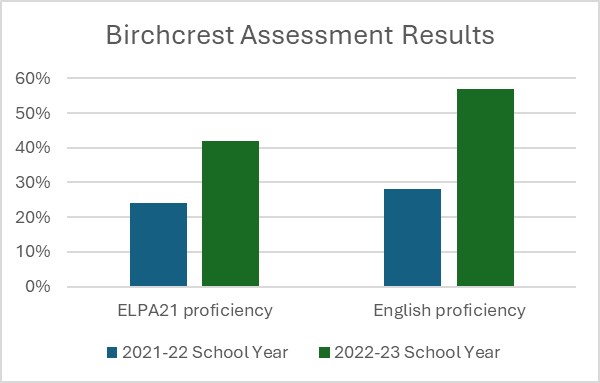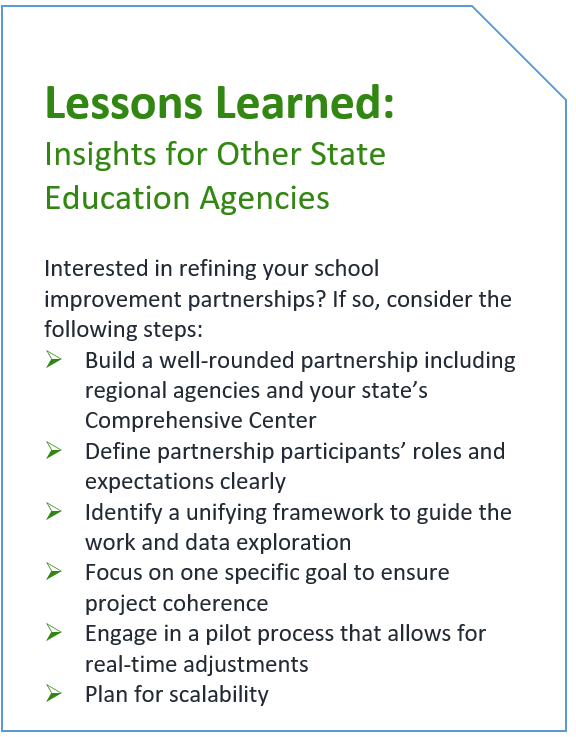Like many state education agencies, the Nebraska Department of Education (NDE) recognized it needed more structure to parts of its school improvement approach. NDE leaders wanted to consider the work through an equity-focused lens, ensuring supports were effective for multilingual students, and create a process that would be replicable, scalable, and sustainable across the state. No small order.
This “order” became the focus of the NDE’s work with the Region 11 Comprehensive Center (R11CC). Together they set a goal of creating a school improvement process that identifies barriers to student learning and helps students and their teachers overcome those challenges with evidence-based solutions. To create this new approach, the NDE and the R11CC established partnerships with agencies located throughout the state and across the educational ecosystem. The NDE and the R11CC shared the role of facilitator, guiding the partnership and keeping the focus on collaboration.
“As a state agency there is a perception of us as being regulators, but we are also capacity builders and change agents,” explained Shirley Vargas, NDE’s school transformation officer. “Our mission is finding out how we support those closest to the work.”
As the R11CC’s 5-year cycle nears its end, members of the partnership are witnessing the fruits of this labor. “This initiative provided us with a professional learning partnership between the school, the district, the ESU [the Educational Service Unit], and Region 11, which focused on high-leverage practices to all teachers of multilingual learners,” said Sue Fjelstad, English learner coordinator for Bellevue Public Schools. “I would strongly recommend school districts participate in this program to improve teaching and learning for all students, but especially your multilingual learners.”
 Establishing the Partnership
Establishing the Partnership
Nebraska identifies schools for Targeted Support and Improvement (TSI) and Additional Targeted Support and Improvement (ATSI) based on yearly student group performance. Comprehensive Support and Improvement (CSI) schools include those that have consistently underperforming student groups for 3 years. In 2019, 100 schools were identified as TSI or ATSI based on achievement gaps for multilingual learners. After initially disseminating resources that all schools could use, the NDE focused its efforts on creating a process for TSI and ATSI schools to help them avoid slipping further into improvement status.
To help the NDE build relationships within individual schools, they turned to the R11CC and the state’s educational service units (ESUs), which play a vital role in the Nebraska educational ecosystem. There are 17 ESUs in Nebraska, and they provide technical assistance to schools within their area and support the NDE with its initiatives. NDE recognized it was imperative that the partnership included representation from the ESUs. “Instead of going directly to schools, as we might have done in the past, we wanted to make sure we leveraged the partnerships that the ESU already has with its member districts to ensure that we are bringing all the necessary partners to the table,” said Vargas.
ESU #3 was a natural partner for the pilot phase because it was well-staffed and already had a strong working relationship with the NDE, according to Jeanette King, the R11CC Nebraska lead. ESU #3 team members were also consistently involved in the NDE’s existing school improvement work.
ESU #3 then helped round out the partnership by identifying a school and district to participate in the pilot. They recommended Birchcrest Elementary, part of Bellevue Public School District, as a strong candidate due to their working relationship as well as the school’s need for support for its multilingual students. Birchcrest agreed to join.
To ensure a successful partnership, before any improvement work could began, the R11CC worked with ESU #3 and the NDE to establish partner roles and responsibilities and created working agreements and commitments in the spring of 2022 so everyone understood the dedication and support necessary for success, said Vargas. The roles were designed to acknowledge each agency’s strengths. “For example, our Region 11 Comp Center staff brings their expertise in evidence-based practices; NDE brings various data sources and rules and regulations; ESU #3 brings staff development support; and our schools and districts bring their assets and their needs,” she said.
Piloting the Multilingual Learner Partnership Process

An improvement process cycle schools can follow when implementing evidence-based strategies.
After defining the project goals and solidifying the partnership, work began at the pilot school to increase Birchcrest Elementary staff’s use of evidence-based instructional strategies to better support their multilingual learners. This would be a multiyear process, beginning in November 2022 and concluding in June 2024, and would involve the support of the NDE, R11CC, ESU #3, district leadership, and leaders, teachers, and specialists at the school.
The first step was to gain clarity by building a shared understanding of the existing situation within the school, said Susan Shebby, R11CC co-director. The partnership guided the school in the use of the ICEL framework, which stands for instruction, curriculum, environment, and learner. “We used this framework because it reflects the important role teacher instructional strategies, learning materials, and environmental influences have on learners’ academic performance. It also encourages the use of multiple data sources, artifacts, interviews and observations, in addition to test scores,” explained Shebby.
Reviewing the findings, the data uncovered gaps in the school’s Tier 1 instruction. The partnership then supported a group of educators representing the school’s teachers and leaders as well as the district’s leaders to investigate best practices for multilingual learners. “This process included looking at evidence-based practices and our English language proficiency standards, and then developing a plan to address the gaps in our data and move our project forward,” said Dawn Ferreyra, educational consultant with ESU #3.
From there, the partnership and the school team co-developed a logic model and action plans to help the instructional leaders understand the process and have a focus, said Fjelstad. “As a team, we determined the why, the participants, input of what resources were needed to succeed, and the action steps needed to be taken in order to accomplish this for them to reach the outcomes,” she said. “As a district leader, this process brought awareness of the need for professional learning and initiated the need for meaningful professional learning opportunities for all staff serving multilingual learners.”

Birchcrest Elementary’s English Language Proficiency Assessment for the 21st Century (ELPA21) proficiency surged from 24% to 42%, and students making progress toward English language proficiency nearly doubled, going from 28% to 57% after participating in the pilot project partnership.
For the school, the work was transformative to student learning, according to Jessica Weber, an instructional coach at Birchcrest Elementary. They started looking at it through the lens of a multilingual learner and then built awareness among staff. “We never talked about English learners, but now that we look at instruction from that perspective, we are all talking about it,” she said. Through focused professional learning community (PLC) meetings, they integrated data into their discussions. They also needed to improve core English language arts (ELA) and selected Teaching Reading: A Playbook for Developing Skilled Readers Through Word Recognition and Language Comprehension for a schoolwide book study with support from the R11CC. ESU #3 guided the work with tailored coaching sessions, while the school’s multilingual learners team also facilitated their own strategic planning and professional learning opportunities.
“Our staff really blossomed, and our students began to really flourish,” Weber said. “The evidence-based practices that we implemented have really been a catalyst to a lot of the growth and change not only for our English learners students, but also for all learners here.” They also got out of status, going from a rating of needs improvement to good. “We were pretty proud of that, but next up for us is moving from that rating of good to great,” she said.
The score increases weren’t limited in scope or scale. “Although we’re focused on improving outcomes for multilingual learners, we’re also recognizing that evidence-based Tier 1 strategies and practices benefit all learners,” said King. “Scores went up, and not just for ELA, but also for math. We know that math involves language. So, when you’re supporting your multilingual learners, all the boats rise because the teachers are now using stronger instructional practices.”
Planning for Scalability

Now the question becomes is it possible to repeat the positive results from one pilot across hundreds of schools working with 17 different ESUs?
At the heart of it will be scaling the partnership. “It takes a partnership to do this work. You can’t expect a school to do it by itself. You can’t expect the State Department of Education to have to do it alone, or an ESU,” said King. “You need all the partners working together to support system change, and that’s why we are really excited, because we’re saying, ‘If you want to do this work, here’s a process that will work.’”
The NDE and the R11CC recently launched a second pilot in northeast Nebraska with South Sioux City Community School District with regional ESU support. This collaboration and support across ESUs will be vital to scaling. The partnership is also working on a facilitator’s guide and corresponding training in the fall for all ESUs if they want to follow the same process with schools in their area.
In addition, the R11CC has been working with the Nebraska Multi-Tiered Systems of Support team, which is housed within the NDE, to coordinate statewide efforts to serve multilingual students. First, they created a series of webinars highlighting four evidence-based practices that are critical to supporting multilingual learners. Next, they will then develop courses to expand upon the webinars, and third, they will roll out trainings to any district or school that is interested in improving outcomes for all learners.
For Birchcrest Elementary and Bellevue Public Schools, leadership believes the sky is the limit. Fjelstad said the district is committed to providing ongoing support, instructional leadership opportunities, and resource sharing through a collaborative learning approach.
“As we continue our journey, we really just feel empowered,” said Weber. “There’s a sense of excitement and a level of determination in our building. Birchcrest isn’t just a school, it’s a beacon of transformation and possibility.”
Contact
For more information about the work being done in Nebraska, please contact R11CC co-directors Susan Shebby and Joe Simpson.
Want to share this story with others? Download a PDF version here.
